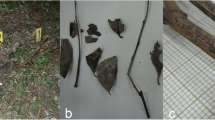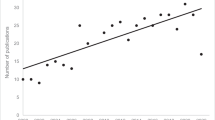Abstract
The presence of domestic dogs Canis familiaris in public open spaces is increasingly controversial. In our review of the literature, we located 133 publications of various types (papers, reports etc.) that examine some aspect of dogs in parks and open spaces (50 % focussed solely on dogs). There has been an exponential growth in the cumulative number of articles (R 2 = 0.96; 82 % published since 1997); almost all pertain to temperate latitudes (97 %) and most to the northern hemisphere (62 %). Most articles focus on impacts on wildlife (51 %), zoonotic diseases (17 %), and people’s perceptions regarding dogs (12 %). Articles mostly describe problems associated with dogs, while reports of low compliance with dog regulations are common. We outline six major findings regarding dogs in parks: (1) there is a paucity of information on dogs in parks, particularly in relation to their interactions with wildlife and regarding their management; (2) published studies are mainly restricted to a handful of locations in developed countries; (3) sectors of societies hold different views over the desirability of dogs in parks; (4) the benefits and risks of dogs to humans and park values are poorly documented and known; (5) dogs represent a notable disease risk in some but not all countries; and (6) coastal parks are over-represented in the literature in terms of potential negative impacts. Park managers globally require better information to achieve conservation outcomes from dog management in parks.




Similar content being viewed by others
References
Acosta-Jamett G, Chalmers W, Cunningham A, Cleaveland S, Handel I, Bronsvoort B (2011) Urban domestic dog populations as a source of canine distemper virus for wild carnivores in the Coquimbo region of Chile. Vet Microbiol 152:247–257
Agardy T, Alder J (2005) Coastal systems. In: Hassan RM, Scholes R, Ash N (eds) Ecosystems and human well-being: current status and trends. Island Press, Washington, DC, pp 513–549
Baker PJ, Bentley AJ, Ansell RJ, Harris S (2005) Impact of predation by domestic cats Felis catus in an urban area. Mamm Rev 35:302–312
Bekoff M, Meaney CA (1997) Interactions among dogs, people, and the environment in Boulder, Colorado: a case study. Anthrozoos 10:23–31
Brickner I (2002) The impact of domestic dogs (Canis familiaris) on wildlife welfare and conservation: literature review. With a situation summary from Israel. http://www.tau.ac.il/lifesci/zoology/members/yom-tov/inbal/dogs.pdf. Accessed 21 June 2014
Butler J, Du Toit J, Bingham J (2004) Free-ranging domestic dogs (Canis familiaris) as predators and prey in rural Zimbabwe: threats of competition and disease to large wild carnivores. Biol Conserv 115:369–378
Davlin SL, VonVille HM (2012) Canine rabies vaccination and domestic dog population characteristics in the developing world: a systematic review. Vaccine 30:3492–3502
Dowling B, Weston MA (1999) Managing a breeding population of the hooded plover Thinornis rubricollis in a high-use recreational environment. Bird Conserv Int 9:255–270
Fekadu M (1982) Rabies in Ethiopia. Am J Epidemiol 115:266–273
Forrest A, St Clair CC (2006) Effects of dog leash laws and habitat type on avian and small mammal communities in urban parks. Urban Ecosyst 9:51–66
Gompper ME (2014) Free-ranging dogs and wildlife conservation. Oxford University Press, Oxford
Green J, Gipson P (1994) Feral dogs. In: Hygnstrom S, Timm R, Larson G (eds) Prevention and control of wildlife damage. University of Nebraska, Lincoln, pp 1–7
Hockin D, Ounsted M, Gorman M, Hill D, Keller V, Barker MA (1992) Examination of the effects of disturbance on birds with reference to its importance in ecological assessments. J Environ Manage 36:253–286
Holderness-Roddam B (2011) The effects of domestic dogs (Canis familiaris) as a disturbance agent on the natural environment. M Env Mgmt Thesis, University of Tasmania, Hobart
Instone L, Mee K (2011) Companion acts and companion species: boundary transgressions and the place of dogs in urban public space. In: Bull J (ed) Animal movements−moving animals: essays on direction, velocity and agency in humanimal encounters. Centre of Gender Research Uppsala University, Sweden, pp 229–250. http://uu.diva-portal.org/smash/get/diva2:420252/FULLTEXT01.pdf
Iojă CI, Rozylowicz L, Pătroescu M, Niţă MR, Vânau GO (2011) Dog walkers vs. other park visitors perceptions: the importance of planning sustainable urban parks in Bucharest, Romania. Landsc Urban Plan 103:74–82
Johnston C, Briggs J, Wallace P (2013) Dog walking review—Mornington Peninsula National Park. Context Consulting, Melbourne
Kofron CP, Chapman A (2006) Causes of mortality to the endangered southern cassowary Casuarius casuarius johnsonii in Queensland, Australia. Pac Conserv Biol 12:175
Kubinyi E, Pongrácz P, Miklósi A (2009) Dog as a model for studying conspecific and heterospecific social learning. J Vet Behav 4:31–41
Le Corre N, Gélinaud G, Brigand L (2009) Bird disturbance on conservation sites in Brittany (France): the standpoint of geographers. J Coast Conserv 13:109–118
Lenth BE, Knight RL, Brennan ME (2008) The effects of dogs on wildlife communities. Nat Areas J 28:218–227
Leseberg A, Hockey PA, Loewenthal D (2000) Human disturbance and the chick-rearing ability of African black oystercatchers (Haematopus moquini): a geographical perspective. Biol Conserv 96:379–385
Lord A, Waas JR, Innes J, Whittingham MJ (2001) Effects of human approaches to nests of northern New Zealand dotterels. Biol Conserv 98:233–240
Lowe CN, Williams KS, Jenkinson S, Toogood M (2014) Environmental and social impacts of domestic dog waste in the UK: investigating barriers to behavioural change in dog walkers. Int J Environ Waste Manag 13:331–347
Lunney D, Gresser S, O’Neill LE, Matthews A, Rhodes J (2007) The impact of fire and dogs on koalas at Port Stephens, New South Wales, using population viability analysis. Pac Conserv Biol 13:189–201
MacArthur RA, Johnston RH, Geist V (1979) Factors influencing heart rate in free-ranging bighorn sheep: a physiological approach to the study of wildlife harassment. Can J Zool 57:2010–2021
Macdonald DW (1980) Rabies and wildlife: a biologist’s perspective. Oxford University Press, London
Maguire GS, Miller KK, Weston MA, Young K (2011) Being beside the seaside: beach use and preferences among coastal residents of south-eastern Australia. Ocean Coast Manag 54:781–788
Mainini B, Neuhaus P, Ingold P (1993) Behaviour of marmots Marmota marmota under the influence of different hiking activities. Biol Conserv 64:161–164
Manor R, Saltz D (2004) The impact of free-roaming dogs on gazelle kid/female ratio in a fragmented area. Biol Conserv 119:231–236
Marcum H (2005) The effects of human disturbance of birds in Bastrop State Park. PhD Thesis, Texas A&M University
McCormack GR, Rock M, Sandalack B, Uribe FA (2011) Access to off-leash parks, street pattern and dog walking among adults. Public Health 125:540–546
Meek PD (1999) The movement, roaming behaviour and home range of free-roaming domestic dogs, Canis lupus familiaris, in coastal New South Wales. Wildl Res 26:847–855
Miller KK (2009) Human dimensions of wildlife population management in Australasia: history, approaches and direction. Wildl Res 36:48–56
Miller SG, Knight RL, Miller CK (2001) Wildlife responses to pedestrians and dogs. Wildl Soc Bull 29:124–132
Miller KK, Ritchie EG, Weston MA (2014) The human dimensions of dog-wildlife interactions. In: Gompper ME (ed) Free-ranging dogs and wildlife conservation. Oxford University Press, Oxford, pp 286–301
Morgan R (1999) Preferences and priorities of recreational beach users in Wales, United Kingdom. J Coastal Res 15:653–667
Nelson C, Morgan R, Williams A, Wood J (2000) Beach awards and management. Ocean Coast Manag 43:87–98
Parks Victoria (2006) Walking your dog in Victoria’s Parks. Parks Victoria, Melbourne. http://parkweb.vic.gov.au/__data/assets/pdf_file/0008/305099/Walking-your-Dog-Brochure.pdf Accessed 4 Nov 2010
Pereira LCC, Jiménez JA, Medeiros C, Costa RM (2003) The influence of the environmental status of Casa Caiada and Rio Doce beaches (NE-Brazil) on beaches users. Ocean Coast Manag 46:1011–1030
Precel N (2009) Swan dead in dog attack. Williamstown Star. http://www.williamstown.starcommunity.com.au/star/2009-11-03/swan-dead-in-dog-attack/. Accessed 2 Nov 2010
Randler C (2006) Disturbances by dog barking increase vigilance in coots Fulica atra. Eur J Wildl Res 52:265–270
Reed SE, Merenlender AM (2008) Quiet, nonconsumptive recreation reduces protected area effectiveness. Conserv Lett 1:146–154
Reed SE, Merenlender AM (2011) Effects of management of domestic dogs and recreation on carnivores in protected areas in northern California. Conserv Biol 25:504–513
Savolainen P, Zhang YP, Luo J, Lundeberg J, Leitner T (2002) Genetic evidence for an east Asian origin of domestic dogs. Science 298:1610–1613
Semken M, Miller K, James K (2011) The value of oral history in natural resource management: the Balcombe Estuary Reserve, Mount Martha, Victoria. Austral J Environ Manag 18:109–122
Silva-Rodríguez EA, Sieving KE (2012) Domestic dogs shape the landscape-scale distribution of a threatened forest ungulate. Biol Conserv 150:103–110
Slater MR, Di Nardo A, Pediconi O, Villa PD, Candeloro L, Alessandrini B, Del Papa S (2008) Cat and dog ownership and management patterns in central Italy. Prev Vet Med 85:267–294
Sterl P, Brandenburg C, Arnberger A (2008) Visitors awareness and assessment of recreational disturbance of wildlife in the Donau-Auen National Park. J Nat Conserv 16:135–145
Vanak AT, Gompper ME (2010) Interference competition at the landscape level: the effect of free-ranging dogs on a native mesocarnivore. J Appl Ecol 47:1225–1232
Walsh J (2011) Unleashed fury: the political struggle for dog-friendly parks. Purdue University Press, West Lafayette
Wandeler AI, Matter HC, Kappeler A, Budde A (1993) The ecology of dogs and canine rabies: a selective review. Revue Scientifique et Technique International Office of Epizootics 12:51–71
Weber RP (1990) Basic content analysis, 2nd edn. Sage Publications, Newbury Park, California
Weston MA, Elgar MA (2005) Disturbance to brood-rearing hooded plover Thinornis rubricollis: responses and consequences. Bird Conserv Int 15:193–209
Weston MA, Elgar MA (2007) Responses of incubating hooded plovers (Thinornis rubricollis) to disturbance. J Coast Res 23:569–576
Weston MA, Stankowich T (2014) Dogs as agents of disturbance. In: Gompper ME (ed) Free-ranging dogs and wildlife conservation. Oxford University Press, Oxford, pp 94–113
Williams KJ, Weston MA, Henry S, Maguire GS (2009) Birds and beaches, dogs and leashes: dog owners’ sense of obligation to leash dogs on beaches in Victoria, Australia. Hum Dimens Wildl 14:89–101
Yalden PE, Yalden D (1990) Recreational disturbances of breeding golden plovers Pluvialis apricarius. Biol Conserv 51:243–262
Yarwood M, Garnett ST, Weston MA (2013) From little things, big things grow; Trends and fads in 110 years of Australian ornithology. Scientometrics 98:1–20
Acknowledgments
This work was funded by grants from Deakin University’s Environmental Sustainability Research Group in the Faculty of Science, Engineering and Built Environment. Write up was assisted by a Faculty Collaborative Research Grant and a School of Life and Environmental Sciences New Initiatives Grant. Amy Shaw contributed to coding. Thanks to Doug Whittaker and two anonymous referees for providing useful feedback on a draft manuscript.
Author information
Authors and Affiliations
Corresponding author
Electronic supplementary material
Below is the link to the electronic supplementary material.
Rights and permissions
About this article
Cite this article
Weston, M.A., Fitzsimons, J.A., Wescott, G. et al. Bark in the Park: A Review of Domestic Dogs in Parks. Environmental Management 54, 373–382 (2014). https://doi.org/10.1007/s00267-014-0311-1
Received:
Accepted:
Published:
Issue Date:
DOI: https://doi.org/10.1007/s00267-014-0311-1




